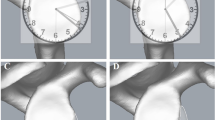Abstract
Objective
In quantifying glenoid bone loss and as a means to determine initial glenoid size, the abnormal glenoid is often compared with the contralateral normal glenoid. The assumption is that good symmetry exists between both glenoid surfaces with regard to size and shape. The purpose of this study is to critically analyze the structural symmetry of both glenoids in an objective and quantitative manner to ascertain the degree of symmetry present.
Materials and methods
The study cohort comprised 60 subjects (35 males and 25 females) with no shoulder pathology or injury. Each glenoid surface was extracted from the whole scapular model constructed from CT data using a 3D curvature-based incremental watershed algorithm. Glenoid morphometric analysis was carried out based on the 2D contour of the glenoid projected on the principal plane.
Results
There was no side-to-side difference in glenoid length (p = 0.53), width (p = 0.42), area (p = 0.36), or circumference (p = 0.73). All glenoid dimensions were larger in males than females (p < 0.05). Point-wise curvature analysis showed no significant shape difference between both glenoids (all p > 0.1). Regression analysis revealed a positive correlation (R 2 = 0.3–0.5) between increasing age and increasing glenoid size.
Conclusions
In normal subjects, both glenoids are highly symmetric in shape and size. This study provides objective and quantitative justification for using the normal counterlateral glenoid as a reference standard for initial glenoid shape in patients with unilateral glenoid bone loss.




Similar content being viewed by others
References
Sugaya H, Moriishi J, Dohi M, Kon Y, Tsuchiya A. Glenoid rim morphology in recurrent anterior glenohumeral instability. J Bone Joint Surg Am. 2003;85:878–84.
Griffith JF, Antonio GE, Tong CWC, Chan KM. Anterior shoulder dislocation: quantification of glenoid bone loss with CT. AJR. 2003;180:1423–30.
Huijsmans PE, Haen PS, Kidd M, Dhert WJ, van der Hulst VP, Willems WJ. Quantification of a glenoid defect with three-dimensional computed tomography and magnetic resonance imaging: a cadaveric study. Journal of Shoulder and Elbow Surgery. 2007;16:803–9.
Diederichs G, Seim H, Meyer H, Issever AS, Link TM, Schröder RJ, et al. CT-based patient-specific modeling of glenoid rim defects: a feasibility study. AJR Am J Roentgenol. 2008;191(5):1406–11. doi:10.2214/AJR.08.1091.
Lorensen WE, Cline HE. Marching cubes: a high resolution 3D surface construction algorithm. Computer Graphics. 1987;21:163–9.
Mangan AP, Whitaker RT. Surface segmentation using morphological watersheds. Proc. IEEE Visualization 1998 Late Breaking Hot Topics [J], 1998.
Abdi H, Williams LJ. Principal component analysis. Wiley Interdisciplinary Reviews: Computational Statistics. 2010;2:433–59.
Bookstein FL. Morphometric tools for landmark data: geometry and biology. Cambridge: Cambridge University Press; 1991. 460p.
Griffith JF, Antonio GE, Yung PS, Wong EM, Yu AB, Ahuja AT, et al. Prevalence, pattern, and spectrum of glenoid bone loss in anterior shoulder dislocation: CT analysis of 218 patients. AJR Am J Roentgenol. 2008;190(5):1247–54.
Weishaupt D, Zanetti M, Nyffeler RW, Gerber C, Hodler J. Posterior glenoid rim deficiency in recurrent (atraumatic) posterior shoulder instability. Skeletal Radiol. 2000;29(4):204–10.
Kwon YW, Powell KA, Yum JK, Brems JJ, Iannotti JP. Use of three-dimensional computed tomography for the analysis of the glenoid anatomy. J Shoulder Elbow Surg. 2005;14(1):85–90.
Scalise JJ, Bryan J, Polster J, Brems JJ, Iannotti JP. Quantitative analysis of glenoid bone loss in osteoarthritis using three-dimensional computed tomography scans. J Shoulder Elbow Surg. 2008;17(2):328–35.
Kushner HI. Why are there (almost) no left-handers in China? Endeavour. 2013;37:71–81.
Acknowledgments
The work described in this paper was supported by a grant from the Research Grants Council of the Hong Kong Special Administrative Region, China (Project No.: CUHK 473012) and grants from the National Natural Science Foundation of China (Project No. 81101111, No. 61233012, No. 81201157, and No. 81271653).
Conflict of interest
All the authors have no conflicts of interest.
Author information
Authors and Affiliations
Corresponding authors
Additional information
This study was approved by The Chinese University of Hong Kong and hospital ethics committee.
Rights and permissions
About this article
Cite this article
Shi, L., Griffith, J.F., Huang, J. et al. Excellent side-to-side symmetry in glenoid size and shape. Skeletal Radiol 42, 1711–1715 (2013). https://doi.org/10.1007/s00256-013-1728-y
Received:
Revised:
Accepted:
Published:
Issue Date:
DOI: https://doi.org/10.1007/s00256-013-1728-y




